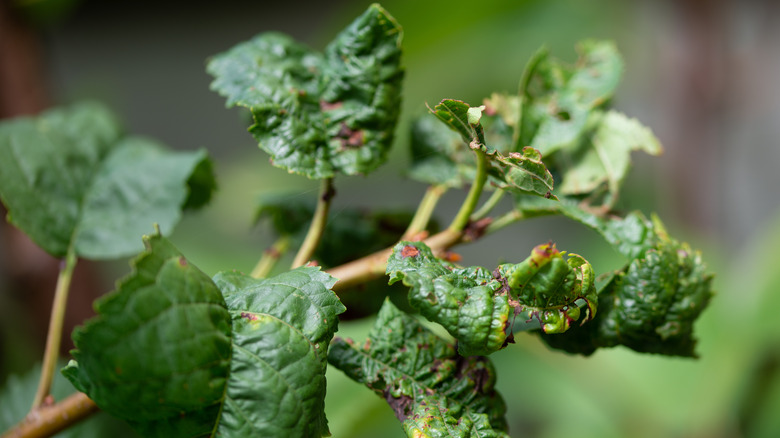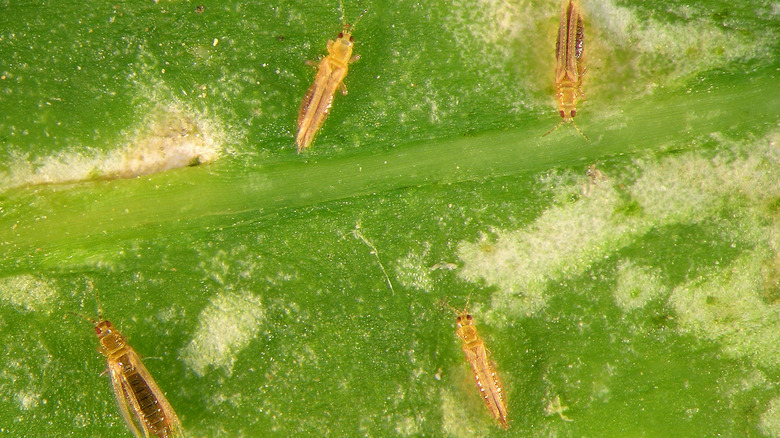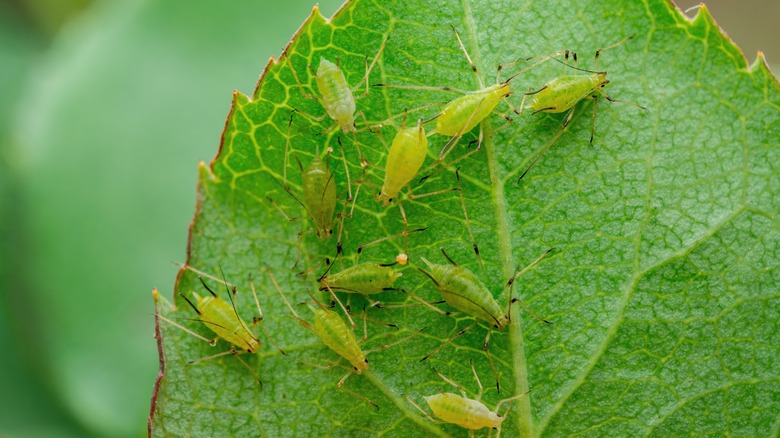Aphids Vs Thrips: Which Destructive Pest Is Attacking Your Garden
When it comes to garden pests, there are more than enough to ruin your plantings, their bounty, and even the soil in which they grow. Some are familiar vermin like moles and beetles, while others have weird names you've never heard of like nematodes and leafminers. Two that perhaps fall into the latter category — at least for beginner gardeners – are aphids and thrips, tiny insects that can cause a great deal of damage. Their small size and similar feeding preferences (as they both like fresh, new growth) mean that they can be easily mistaken for each other, but it's important to know the differences between the two so they can be properly identified and effectively managed. These include distinctions in their appearance, color, and how they damage plants.
Both topping out at about ⅛ of an inch (just over 3 millimeters) long, aphids and thrips are still visible to the naked eye but mostly because they come in droves. There's simply never just one aphid or a lone thrip on your newly-budding plant. Instead, it's usually hundreds, if not thousands. Even then, since they hide on the undersides of leaves and flower petals, your first indication that they've settled into your garden may be noticeable damage on leaves. For both these insects, you may notice a curling and yellowing effect, and they can also both spread various diseases to the plant. However, they also damage plants in different ways as well that make them distinct from one another.
Thrips have wings
One of the most obvious differences between thrips and aphids is that only thrips have wings. They're also oblong and slim-bodied. Generally either black or pale yellow in color, they can also have stripes of the two colors. While they have the potential to be as big as an aphid, they can also be much smaller, making them fast-moving. Their pierced mouths not only cause damage to foliage as they feed on it but can also transmit viruses to the plants. Thrips lay eggs that grow into adults over the next six weeks at most, meaning that they can spawn 15 generations each year. The young nymphs, while much tinier, are more similar to aphids in color, ranging from light green to yellow.
Thrips cause harm to leaves and other foliage by sucking the nutrients out of the cells, leaving streaks that look like dried-out, desiccated veins in the plant structure. You might also notice white patches, silver speckling, or even some brown excrement. You can typically repel thrips with sprays of water, dormant oil, or even by releasing ladybugs. They're also likely to simply fly away if you approach them. To positively identify if you're actually working with thrips and not aphids, shake the infected flora over a white piece of paper. If thrips are present, they'll fall off and you'll be able to observe them more closely to possibly notice their wings.
Aphids clone themselves
Aphids are one of the most common garden pests, possibly because the females give birth to live clones throughout the summer (yes, clones, since they don't have to be produced through mating) at a rate of about 80 per week. This can obviously leave you with a huge aphid problem in a matter of days, so it's imperative that you act quickly the moment you spot them. These pests are usually green but come in other colors like red, brown, and even black. They have a somewhat rounded, pear-shaped body — no doubt to help with all those births — and what looks like two dark tails.
Aphids will leave your plants looking frail and wilted as they drain them of all their nutrients, and you may notice their leaves curling inward as well, almost in a protective gesture. One of the first ways lots of people notice aphids, however, is through the presence of ants. These pests leave a sticky trail in their wake called "honeydew" that ants find irresistible. While some thrips can also produce honeydew, only a small amount do. A line of ants is often easier to spot than tiny aphids, and the residue itself invites a sooty mold on the leaves that is also quite visible. Just like with thrips, there are many natural ways to get rid of aphids including with simple soap and water, so it's possible to keep your garden healthy without resorting to chemical warfare.


